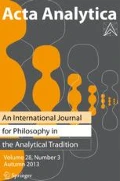Abstract
A central motivation for the type-token model of music works is its ability to explain musical multiplicity—the fact that musical works are capable of having multiple performances through which they can be experienced and which cannot be individually identified with the works themselves. The type-token model explains multiplicity by identifying musical works with structural types and taking performances to be tokens of those types. In this paper, I argue that musical works are flexible in ways which permit performances which are tokens of distinct structural types to be performances of the same musical work. And I argue that various attempts to reconcile the type-token model with musical flexibility are ultimately unsuccessful.
Similar content being viewed by others
Notes
There may also be other physical objects in which a work is in some sense “embodied” but through which the work cannot be experienced. For example, although a musical work may be embodied in (a copy of) a musical score, most of us at least cannot experience the work by means of reading the score.
Musical multiplicity, as formulated, presupposes the identification of musical works with musical compositions. In certain genres, however, this presupposition is contentious. It has been argued, for example, that in rock music works should instead be identified with recordings (Kania, 2006); and it has been argued that in jazz they should be identified with performances (Alperson, 1984). And, if this is right, even if jazz and rock compositions are multiple in the relevant sense, jazz and rock works might not be. Nevertheless, in this paper, I will follow the convention of formulating the issue in terms of works.
It is worth noting, however, that Friedell (2018) defends an account of musical flexibility according to which musical works can undergo change only in their extrinsic properties.
It is, of course, true that some performances might be considered aesthetically inferior to others. But it does not follow from the fact that a performance is aesthetically flawed in some respect that it is incorrect in the sense of being an improperly formed instance of a musical work.
One might object that as long as the duration during which a particular structural type is the value of the function in question is long enough, the type-token relation can contribute to the explanation of musical multiplicity even if it cannot provide a complete explanation of the phenomenon. This seems right, but it is worth noting that the view that musical works are functions from times to structural types still runs afoul of performance flexibility.
This objection is due to an anonymous referee for Acta Analytica.
Strictly speaking, Dodd’s concern here is with the temporal flexibility rather than performance flexibility, but presumably his response would be the same.
This suggestion comes from an anonymous referee for Acta Analytica.
As should be clear, this counts as a variant of the continuant-stage model discussed above. As a result, one might identify musical works themselves with fusions or networks of appropriately related performances, or perhaps, take them to be higher-order entities dependent on but distinct from such performances.
See Alward (2020) for a more fully developed version of this view.
References
Abraham, G. (1979). The concise Oxford history of music. Oxford University Press.
Alperson, P. (1984). On musical improvisation. Journal of Aesthetics and Art Criticism, 43(1), 17–29.
Alward, P. (2004). The spoken work. Journal of Aesthetics and Art Criticism, 62(4), 331–337.
Alward, P. (2020). Multiplicity, Audibility, and Musical Continuity. Dialogue 59 (1):101–21.
Caplan, B., & Matheson, C. (2006). Defending musical perdurantism. British Journal of Aesthetics, 46, 59–69.
Davies, D. (2004). Art as performance. Blackwell.
Davies, D. (2009). Dodd on the ‘audibility’ of musical works. British Journal of Aesthetics, 49(2), 98–108.
Davies, S. (2003). Ontology of art. In J. Levinson (Ed.), Oxford Companion to Aesthetics (pp. 155–180). Oxford University Press.
Dodd, J. (2002). Defending musical platonism. British Journal of Aesthetics, 42, 380–402.
Dodd, J. (2004). Types, continuants, and the ontology of music. British Journal of Aesthetics, 44, 342–360.
Dodd, J. (2007). Works of music: An essay in ontology. Oxford University Press.
Dodd, J. (2008). Musical works: Ontology and meta-ontology. Philosophy Compass, 3(6), 1113–1134.
Evans, G. (1978). Can there be vague objects? Analysis, 38(4), 208.
Evnine, S. (2009). Constitution and qua objects in the ontology of music. British Journal of Aesthetics, 49(3), 203–217.
Friedell, D. (2018). Why can’t I change Bruckner’s Eighth Symphony? Philosophical Studies, 177, 805–24.
Goehr, L. (1994). The imaginary museum of musical works. Oxford University Press.
Kania, A. (2006). Making tracks: The ontology of rock music. Journal of Aesthetics and Art Criticism, 64(4), 401–14.
Kivy, P. (1983). Platonism in music: A kind of defense. Grazer Philosophische Studien, 19, 109–129.
Levinson, J. (1980). What a musical work is. The Journal of Philosophy, 77, 5–28.
Moruzzi, C. (2018). Every performance is a stage: Musical stage theory as a novel account for the ontology of musical works. Journal of Aesthetics and Art Criticism, 76(3), 341–351.
Rohrbaugh, G. (2003). Artworks as historical individuals. European Journal of Philosophy, 11, 177–211.
Salmon, N. (1998). Nonexistence. Nous, 32(3), 277–319.
Tillman, C. (2011). Musical materialism. British Journal of Aesthetics, 51, 13–29.
Author information
Authors and Affiliations
Corresponding author
Ethics declarations
Conflict of Interest
The authors declare no competing interests.
Additional information
Publisher's Note
Springer Nature remains neutral with regard to jurisdictional claims in published maps and institutional affiliations.
Rights and permissions
About this article
Cite this article
Alward, P. Musical Types and Musical Flexibility. Acta Anal 38, 355–369 (2023). https://doi.org/10.1007/s12136-022-00518-z
Received:
Accepted:
Published:
Issue Date:
DOI: https://doi.org/10.1007/s12136-022-00518-z




